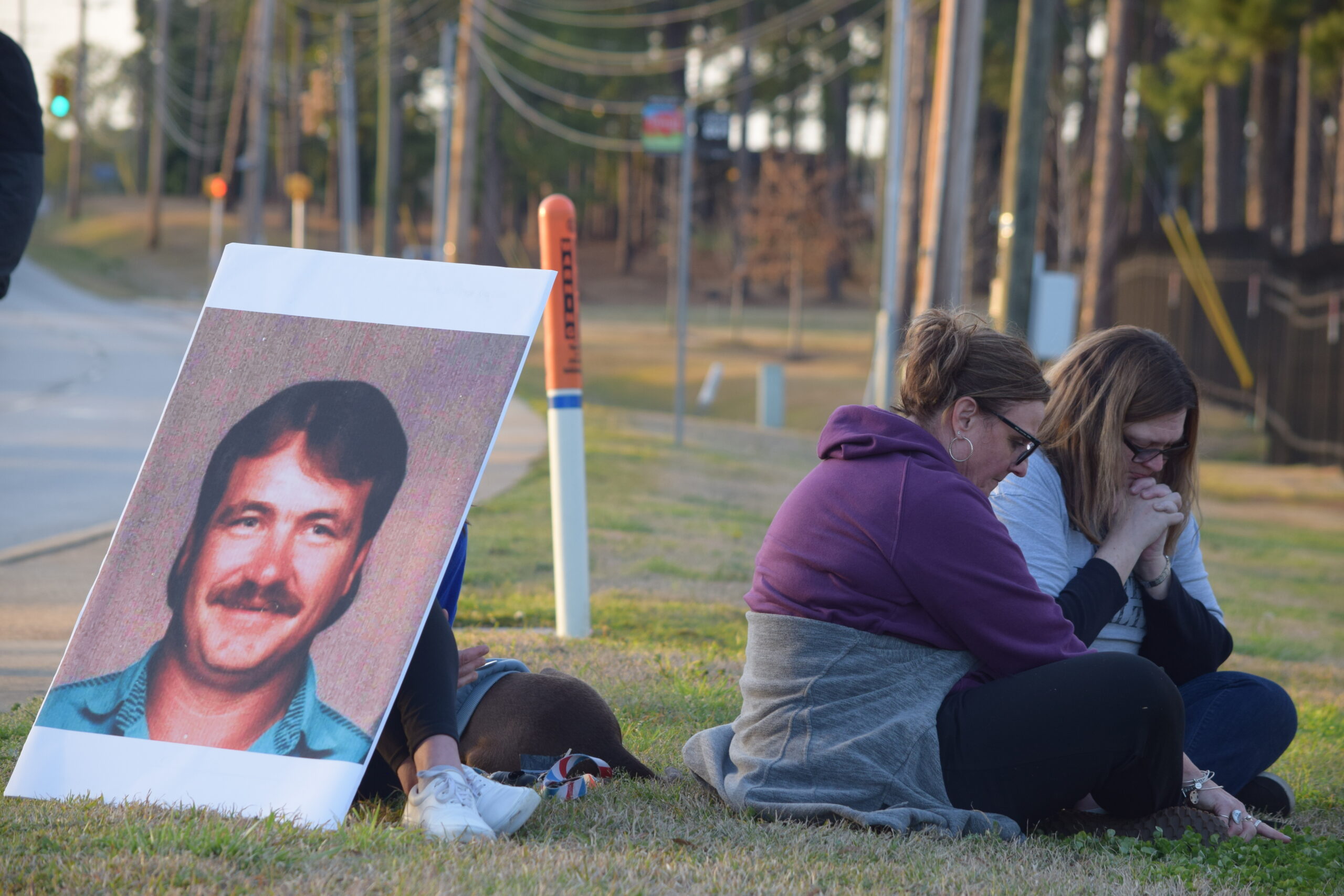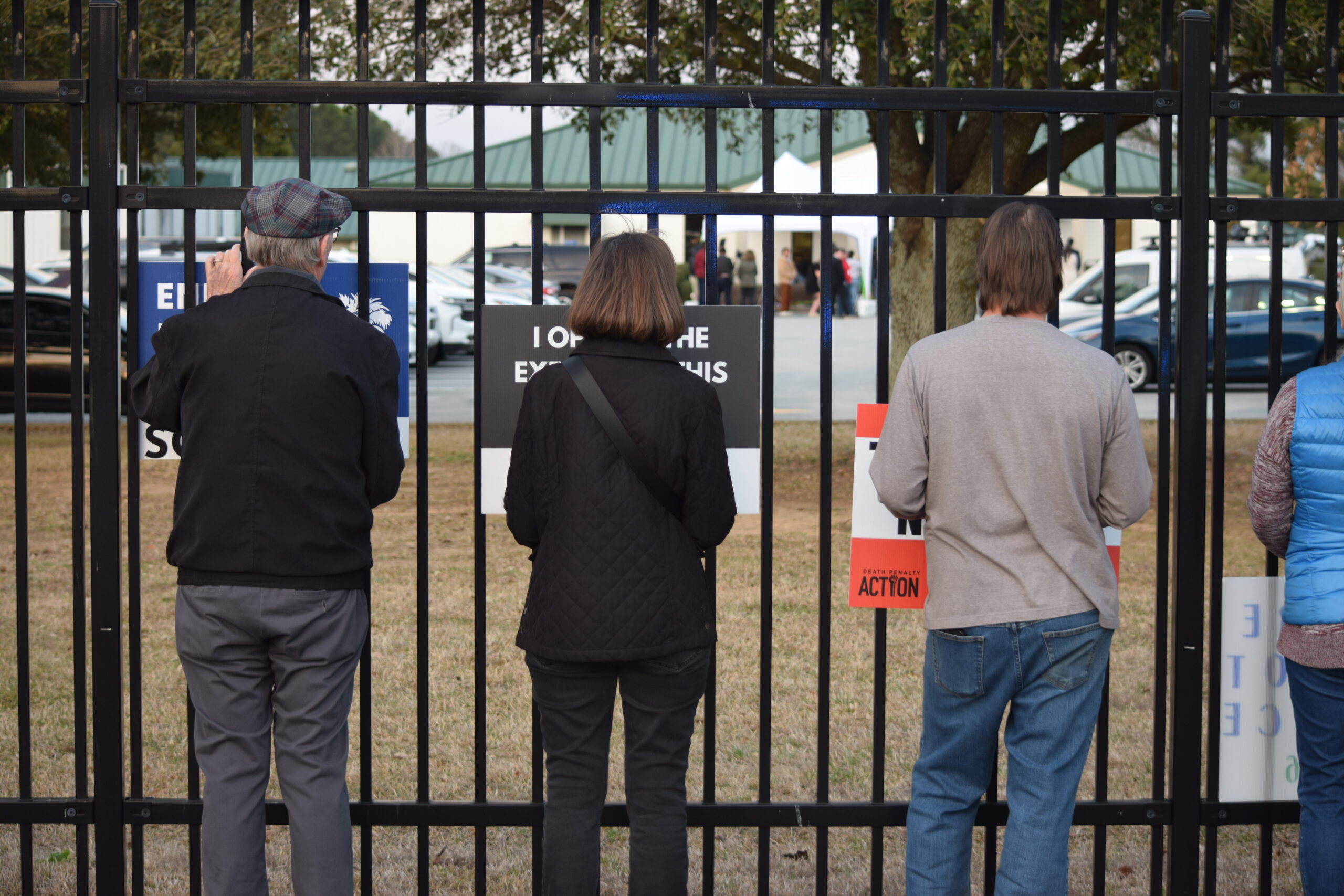
COLUMBIA (South Carolina Daily Gazette) — Brad Sigmon on Friday became the first inmate executed by firing squad in South Carolina.
He was pronounced dead at 6:08 p.m.
“South Carolina has ended the life of a man who has devoted himself to his faith, and to ministry and service to all around him,” read a statement issued by Gerald “Bo” King of the federal public defender’s office on behalf of Sigmon’s legal team.
“Brad admitted his guilt at trial and shared his deep grief for his crimes with his jury and, in the years since, with everyone who knew him,” it read.
Sigmon was convicted in 2002 of killing David and Gladys Larke in their Greenville home, then kidnapping their daughter — his ex-girlfriend, Rebecca Barbare — who managed to escape.
South Carolina justices turned down his final appeal in state court Tuesday. The U.S. Supreme Court issued a denial to intervene less than two hours before his scheduled execution. Gov. Henry McMaster then declined to grant clemency.

At 67, Sigmon was the oldest person ever executed in South Carolina. He was also the first person put to death by firing squad in the United States since 2010, when Ronnie Lee Gardner chose the method in Utah.
Three other inmates have been put to death in South Carolina since executions resumed in September following an unintentional 13-year hiatus. All three chose to die by lethal injection.
The execution
The prison agency’s protocol for the firing squad called for Sigmon to be strapped to a chair in the state’s death chamber, facing a rectangular hole in the wall 15 feet away.
His head, chest, arms and ankles were already strapped when the curtain separating witnesses from the death chamber opened at 6:01 p.m., media witnesses said after the execution.
A gaiter mask obscured his mouth. A white target with a red bullseye printed on it covered his heart.
Sigmon looked toward his attorney and appeared to mouth a few words that witnesses couldn’t make out. He and his spiritual advisor, who sat in the front row, nodded toward each other, witnesses reported.
In his last statement (printed in full below), Sigmon reaffirmed the Christian faith to which he committed himself in prison and called for an end to the death penalty.
“An eye for an eye was used as justification to the jury for seeking the death penalty,” Sigmon wrote in the statement read by King. “At that time, I was too ignorant to know how wrong that was. Why? Because we no longer live under the Old Testament law but now live under the New Testament.”
Along with the spiritual advisor and attorney, three unidentified members of the Larke family and representatives from the solicitor’s office and Greenville County Sheriff’s Office watched.
A prison employee placed a black hood over Sigmon’s head that came down to his shoulders, then opened a black shade that had covered a hole in the brick wall.
Sigmon appeared to take several deep breaths.
According to protocol, the firing squad consisted of three volunteer corrections officers, all using live ammunition, aiming for the target over Sigmon’s heart.
At 6:05 p.m., the gunmen shot through the opening. Sigmon’s arm tensed. His chest moved two or three times. The bullets seemed to enter his chest right over his heart, witnesses said.
A doctor entered the room and examined Sigmon for about 90 seconds before declaring his time of death. No blood could be seen beyond a small patch over his heart where the bullets hit, witnesses said.
The execution went faster than previous ones by lethal injection, according to a witness who has seen all four since September.
According to what officials previously told the state Supreme Court, the gunmen used .308 Winchester bullets, which expand and fragment on impact, causing a more “instantaneous” death.
Sigmon’s last meal, which he had Wednesday, was four pieces of fried chicken, green beans, mashed potatoes and gravy, biscuits, cheesecake and sweet tea, said prison spokeswoman Chrysti Shain.
According to his legal team’s statement, Sigmon asked for three buckets of Original Recipe KFC “so he could feed the men locked up with him. That request was denied.”
Protocol requires that all food must come from the prison’s kitchen.
How it became an option

Legislators added the firing squad as an option in 2021, amid struggles to get the drugs needed for lethal injection. The same law changed the default method of execution from lethal injection back to electrocution.
Some, including legislators and attorneys for the state, have argued firing squad is a quicker and less painful death than lethal injection and electrocution. The state Supreme Court ruled in July that firing squad and electrocution were constitutional methods.
Firing squad “comes as close to a ‘painless death’ — not guaranteed by the constitution — as any method of execution is likely to come,” Justice John Few wrote in the majority opinion.
A U.S. Supreme Court justice seemed to agree in a 2017 opinion. Justice Sonia Sotomayor, who’s considered a liberal justice, believed the nation’s high court should halt the lethal injection execution of an Alabama inmate and allow him to die by his preferred method, the firing squad, despite state law not allowing it.
“In addition to being near instant, death by shooting may also be comparatively painless,” Sotomayor wrote in her dissent. “And historically, the firing squad has yielded significantly fewer botched executions.”
Sigmon was the fourth person executed by firing squad since the U.S. Supreme Court allowed executions to resume nationally in 1976. While five states — Idaho, Utah, South Carolina, Oklahoma and Mississippi — allow the method, only Utah has used it in that timeframe, according to the Death Penalty Information Center.
Sigmon’s crime
The evening of April 26, 2001, while drinking and smoking crack cocaine with a friend, Sigmon said he planned to go to the Larkes’ house the next morning to kidnap Barbare and disappear with her after tying up her parents so they couldn’t call the police, the friend later testified.
Barbare had recently broken up with Sigmon, who continued to live in the trailer they had shared on the Larkes’ property. Obsessed with the idea of her dating another man, he had been stalking her, according to court documents.
“Was I obsessed with her? Yes,” Sigmon later testified. “Did I love her? I loved her more than anything in this world. And I didn’t want to lose her.”
Sigmon went to the Larkes’ house the next morning and attacked 62-year-old David and 59-year-old Gladys with a baseball bat. He went back and forth between where they lay in the kitchen and the living room, hitting them in the head repeatedly until both were dead. Each was struck nine times, according to court records.
When Barbare returned home, Sigmon forced her back into her car at gunpoint — using her father’s gun. She opened the door as the car was moving, jumped out and ran. Sigmon shot at her, hitting her once in the foot. After Barbare escaped, Sigmon fled, prompting a manhunt.
Authorities found Sigmon at a campground in Gatlinburg, Tennessee, after using a wire tap on his mother’s phone, which he called while on the lam. He later told police he had planned to kill himself and Barbare, officers later testified.
“I hate what I did,” Sigmon testified. “My family raised me to be better than that. They raised me to do right. And it ain’t the drugs. It ain’t the alcohol. It ain’t (Barbare). It was me.”
Sigmon never denied what he did, even telling the jury during his trial, “I am guilty.” His attorneys gave no evidence to the contrary, but Sigmon decided not to enter a guilty plea because he wanted a jury to decide his fate, according to court records.
“Do I deserve to die?” Sigmon testified during his trial. “I probably do. I probably do.”
“I don’t want to die,” he continued. “It would kill my mom, my brothers and my sisters.”
Final appeals
Sigmon’s attorneys claimed in last-ditch appeals that a jury never heard evidence about his bipolar disorder, brain damage and childhood trauma.
Sigmon’s then-undiagnosed mental illness and trauma caused him to have “a manic and irrational episode akin to a psychotic break,” which led to him killing the Larkes, his attorneys claimed in court filings last month.
But Sigmon’s attorneys did call witnesses to testify about Sigmon’s mental illness, brain damage and trauma during his sentencing, the court wrote Tuesday in denying their request. Even if they hadn’t, that likely wouldn’t have been enough to convince jurors to change their minds, justices wrote.
Sigmon also asked the court to pause his execution long enough to hear arguments as to whether the lethal injection the state used in its past three executions since September is as safe as officials say.
Sigmon didn’t have enough time or information to decide whether lethal injection would be preferable to the other available methods, his attorneys argued. If he knew more about the state’s process, he might have chosen differently, they wrote in petitions to state and federal courts.
Under a 2023 law meant to make it possible for the state to acquire drugs used in lethal injections, nearly everything about the drugs and the protocol is kept secret. Officials have maintained the state has followed that protocol in all three executions performed since September.
Autopsies of Richard Moore and Marion Bowman showed the drug, administered in two doses each time, made the men’s lungs swell with blood and fluid and “causes the sensation of drowning,” the attorneys wrote in their petition Wednesday to the U.S. Supreme Court.
Death penalty opponents read from Bible that belonged to executed inmate
Freddie Moore, before he was put to death by lethal injection in September, opted out of an autopsy for religious reasons.
That swelling, known as pulmonary edema, is common in deaths caused by lethal injection, state Attorney General Alan Wilson wrote in response. Doctors have presented evidence in some cases that the fluid rushing to inmates’ lungs doesn’t occur until after the inmate is already dead, his response continued.
Besides, Sigmon didn’t choose that method, so how it affected other inmates shouldn’t matter to him, Wilson wrote.
David and Gladys Larke
David and Gladys Larke’s children were still counting on them when they died, their children testified during Sigmon’s 2002 trial.
David was helping his son, Darrell Larke, build a house to live in. Gladys was supposed to go to an ultrasound appointment with her pregnant daughter, Renee Smith, two weeks after her death.
Gladys “was counting the days down to find out if it was going to be a boy or girl,” Smith said at the time.
The two were “the center of everything that we did,” Darrell Larke testified.
“Every morning when I wake up, I see his marks at my house, knowing that he will never see that house that he built with me,” Darrell Larke said about his father.
The Larkes had three daughters and two sons. They were both retired, Gladys from clothing factory Stone Manufacturing and David from Renfrew-Kerr Finishing Company, according to their obituaries.
Smith lived next door to her parents and went over every night for dinner. Her dad would always sit in his chair in the living room or on the front porch while her mother cooked, she said.
The family would gather for every holiday. But after David and Gladys died, they stopped, Smith said.

“It just seems like I’m living somebody else’s life, because we used to be a family and it’s just like that part of it is gone,” Smith said.
In a recent interview with USA Today, her first since the crime, Barbare said she didn’t believe in the death penalty but believed Sigmon needed to answer for what he had done.
“The Bible tells you, I know it says ‘an eye for an eye’ and ‘a tooth for a tooth’ but if you read on down in there it says, ‘Revenge is not mine, says the Lord, revenge is God’s,” Barbare, whose last name is now Armstrong, told USA Today. “I don’t think somebody being put to death is gonna bring me closure … It bothers me and gives me anxiety about him being put to death, and especially him picking the firing squad.”
Brad Sigmon
On death row, Sigmon has become known as an “informal chaplain” who mentors other inmates, said Rev. Hillary Taylor, director of South Carolinians for Alternatives to the Death Penalty. He has been known to use his commissary funds to help other inmates who have less than him, said Taylor, who has been Sigmon’s spiritual advisor for the past four years.
Sigmon has long been devout. While he hid out in Tennessee, he brought with him a Bible that he read from, he testified during his trial. He recommitted himself to his faith after his arrest, he told the court.
“That’s all I got left,” Sigmon testified about his religion. “I got nothing else. That’s all I have.”
Once, after completing a course with a church that does services for inmates, he requested that the Bible he was meant to receive go to his 10-year-old grandson instead, according to a letter provided by his attorneys.
“What book is more important then (sic) God’s word,” Sigmon wrote. “I so want him to learn about Jesus while he is still young.”
Sigmon has multiple penpals, some of whom he has been exchanging letters with for over a decade, Taylor said. He has asked some of those penpals to send him books of jokes that he can use to make other inmates laugh, she said.
Sigmon was close with his son, Robbie Sigmon, the son testified during Sigmon’s trial. One year for Robbie’s birthday, Sigmon skipped paying his insurance bill so he could buy a dirt bike, his son testified.
“We used to play all the time,” Robbie Sigmon said. “He’d come home from work, and he’d play outside with us. Me and my daddy had a good relationship.”
As the oldest of five siblings, Sigmon learned to care for his family from a young age, Taylor said. He began working in a factory as a teenager to help pay for food. When a younger brother was injured and struggled to walk, 13-year-old Sigmon would carry him on his back, Taylor said.
“He was always the peacemaker,” Sigmon’s father, Ronnie Sigmon, testified during his trial. “That’s what’s so shocking about all this. He’s the one that stopped the fights.”
The statement issued by Sigmon’s attorneys after he was executed noted that he was never violent in his 23 years on death row.
“Brad devoted himself every day to prayer and repentance,” it read. ” In these last days of his 23 years on death row, Brad spent hours kneeling on the floor of his cell so he could write letters to the family and friends for whom he has been a wellspring of love and support.”

Sigmon’s last words
“I want my closing statement to be one of love and a calling to my fellow Christians to help us end the death penalty.
An eye for an eye was used as justification to the jury for seeking the death penalty.
At that time, I was too ignorant to know how wrong that was. Why? Because we no longer live under the Old Testament law but now live under the New Testament.
Matthew 5:38-39 says “You have heard that it has been said, ‘An eye for an eye and a tooth for a tooth’ but I say unto you that you do not resist an evil person. Whosoever shall smite me on the right cheek, turn to him the other one as well.”
Romans 6:14, “For sin shall not have dominion over you, for you are no longer under the law but under grace.”
Nowhere does God in the New Testament give man the authority to kill another man.
That is why the Bible is divided into the Old Testament and the New Testament.
Remember the words of Jesus, John 7:19, “Did not Moses give you the law? Yet none of you keep with the law.
We are now under God’s grace and mercy.”






